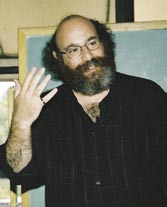 Bill Bialek. Photo by Nell Campbell
Bill Bialek. Photo by Nell Campbell
The Ultimate Interdisciplinary Rendezvous?
Here's a question that appeals to physicists: Is the way in which we represent and process information in our brains deeply related to the structure of the world in which we live?
Here’s another question: What does the first question imply about the interests and approach of physicists exploring the phenomenon of life, in contrast to biologists?
University of Pennsylvania physicist Vijay Balasubramanian, one of seven organizers of the three-month, 2004 KITP workshop “Understanding the Brain,” is collaborating with Penn neuroscientist Peter Sterling to investigate how the structure of natural scenes influences the design of retinal cells. The formulation of that research question shows what physicists can bring to collaboration with biomedical scientists — i.e., point of view. In a way, the physicist looks at the eye from the outside in, whereas biologists have generally looked at the eye from the inside out.
Point of view is strikingly evinced by the title of a KITP public lecture (watch below) by another of the “Brain” workshop organizers, Princeton physicist William Bialek, who headlined his talk “From Photons to Perception: A Physicist Looks at the Brain.”
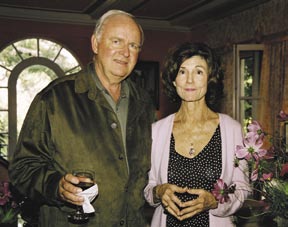 Hunter Hosts Biological Physics Talk by Bill Bialek for Friends of KITP. Pictured: Bruce Mc Fadden and Host Virginia Castagnola-Hunter by Nell Campbell
Hunter Hosts Biological Physics Talk by Bill Bialek for Friends of KITP. Pictured: Bruce Mc Fadden and Host Virginia Castagnola-Hunter by Nell Campbell
Why the emphasis on photons and eyes when the subject is the brain? In a discussion after his public lecture, Bialek said, “Pick a neuron in the human brain, in any primate brain for that matter. That neuron is most likely involved in vision."
“Armed with eyes, ears, noses, and the sensors in our skin,” said Bialek, “our brains take in enormous amounts of data, and for the most part we make sense out of all these data without even being aware that we are solving very difficult problems — problems that still defeat the most powerful computers. There are obvious advantages to accomplishing these tasks more efficiently, but the laws of physics tell us that there are limits to how precisely an organism or machine could function. Remarkably, animals operate very close to these fundamental physical limits, so that our sensory systems are ‘almost perfect.’”
In his talk Bialek gave examples of this perfection and showed that in order for organisms to operate near the physical limits they build “special mechanisms whose structure we can predict from physical principles.”
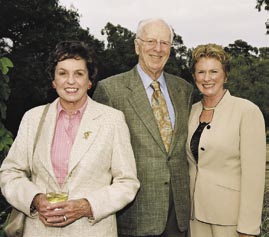 Ruth and Gene Ellis with Linda Gluck (r). Photo by Nell Campbell
Ruth and Gene Ellis with Linda Gluck (r). Photo by Nell Campbell
In effect, said Bialek, “It means aspects of our biology are driven by the world around us.”
The “Brain” workshop is not the first venture of the KITP into the realm of biology and the brain. Beginning with a program on “Neural Networks” in 1986, and one on “Physics of Biomembranes” in 1994, the interval between biologically oriented programs has been growing dramatically shorter. “Electrostatic Effects in Complex Fluids and Biophysics” occurred in 1998, and “Statistical Physics of Biological Information” in 2001. Two of the six programs in 2003 focused on biological issues: “Bio-Molecular Networks” and “Pattern Formation in Physics and Biology.”
Bialek was himself a postdoctoral fellow at the KITP from 1984 to 1986. Unlike many a biophysicist such as Balasubramanian, the string theorist, Bialek was always and only a biophysicist. He got his PhD through an interdepartmental program spanning the departments of physics at Berkeley and a biology department, which typical of biology departments over the last quarter century of the field’s rapid evolution, “has changed its name several times,” said Bialek.
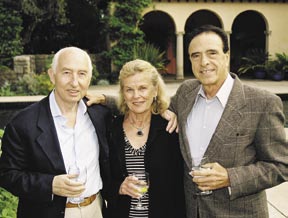 Stuart Mabon with Tunny and Joe Alibrandi (r). Photo by Nell Campbell
Stuart Mabon with Tunny and Joe Alibrandi (r). Photo by Nell Campbell
Asked why he was attracted to biophysics from the outset of his career, Bialek said, “I liked the mathematical style in physics departments — the way physicists thought about problems. On the other hand, the objects of study in biology departments interested me more. I think some disciplines define themselves by the object of study; and others, by the style of inquiry. I would like to think physics is a subject defined by style of inquiry. People who study different objects can enjoy each other in physics departments; you don’t find that in biology departments. There is some uniformity of inquiry in molecular biology, but fundamentally biology is defined by object of study. So it means something to be a physicist interested in the phenomena of life, which is different from being a biologist who happens to use ideas and tools from physics.”
Or, to answer in more “phenomenological” if not psychological terms, Bialek said, “I would go to biology seminars and be fascinated about what they were talking about, but not satisfied with the approach and would have ideas about what I wanted to do. In physics seminars I would appreciate what they were doing, but I didn’t have any original ideas about what to do next.”
The KITP 2004 “Brain” workshop represents the merger of two competing proposals for an originally planned one-month workshop.
Neural coding
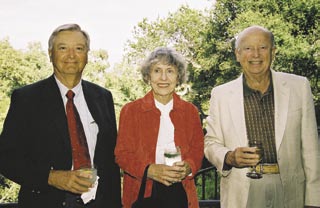 Hugh and Susie Vos and Bob Morefield (r). Photo by Nell Campbell.
Hugh and Susie Vos and Bob Morefield (r). Photo by Nell Campbell.
One proposal focused on neural coding. According to Bialek, “All the information we take in from the outside world and all the information we send out to our muscles and presumably all the internal representations of our thoughts and dreams are sequences of pulses called action potentials or 'spikes.' There’s a longstanding question of trying to understand the structure of that code, and there are very practical reasons for understanding it. For instance, for people paralyzed it would be delightful to read out from their motor cortex the plans they envision sending to their muscles and send them to a robot arm. At the same time, there are theoretical reasons to be interested in why the nervous system chose the code it did: Why and in what way are the codes adaptive? Do the codes serve to optimize abstract quantities like the amount of information and the efficiency with which the information is represented?"
“Thinking about those optimization problems leads to thinking about the relationship between the code the nervous system has constructed and the structure of the physical world,” said Bialek. And, in fact, the other proposal for a “Brain” workshop focused on “optimization” in its many different forms.
And optimization
“If you compare a cross-section of a human brain with a cross-section of a mouse brain,” said Bialek, “a striking difference is in the amount of the white matter for long distance connections. The amount is gigantic in humans whereas in the mouse the amount is much smaller, even in proportion to the size of the brain."
“Take a cubic millimeter of human brain,” said Bialek, “and trace the wires that pass through it and lay them end to end; they extend four kilometers. Many people are interested in whether the basic structure of the brain is shaped by the need simply to solve the physical problem of packing in all the connections, much the way the design of computer chips is dominated by the problem of connecting everything.”
Questions about energy efficiency also arise. “The cost of running the brain is substantial,” said Bialek, “and we run close to the margin — i.e., we can’t go long without feeding the brain without passing out. What is all that energy going for? What is the cost of representing and processing information?”
Finally is the problem of noise, whose effect scales up when size scales down. “The tremendous miniaturization in the brain means that we do things with shockingly few molecules,” said Bialek. “In extreme cases we are capable of responding to individual molecular events as when we see single photons in the retina.”
Packing and connection, energy efficiency, and noise in conjunction with miniaturization represent a complex of issues surrounding the idea of optimization, but also pertain to ideas of coding. “There was enough of an overlap between issues of coding and of optimization,” said Bialek, “that we decided to bring the two together for a three-month workshop."
“The discussions have been productive,” he said. “There is real interaction among the different disciplines [represented by the 76 participants]. What is special here is that the physics community has taken the lead, and at one of the premier places for physicists to get together. That means people are wandering the halls of a theoretical physics institute who haven’t set foot in a physics department since they were freshmen.”
The brain, so it seems, may be the quintessential meeting place for the disciplines.
In addition to physicists, Bialek and Balasubramanian, workshop organizers included University of Pittsburgh neuroscientist Andrew Schwartz, Princeton molecular biologist Michael Berry, Cold Spring Harbor neuroscientist Dmitri Chklovskii, Cambridge zoologist Simon Laughlin, and Arizona State University electrical engineer Jennie Si. Both Berry and Chklovskii also trained as physicists.
Click above to play From photons to perception: A physicist looks at the brain or watch at http://online.kitp.ucsb.edu/online/plecture/bialek/

